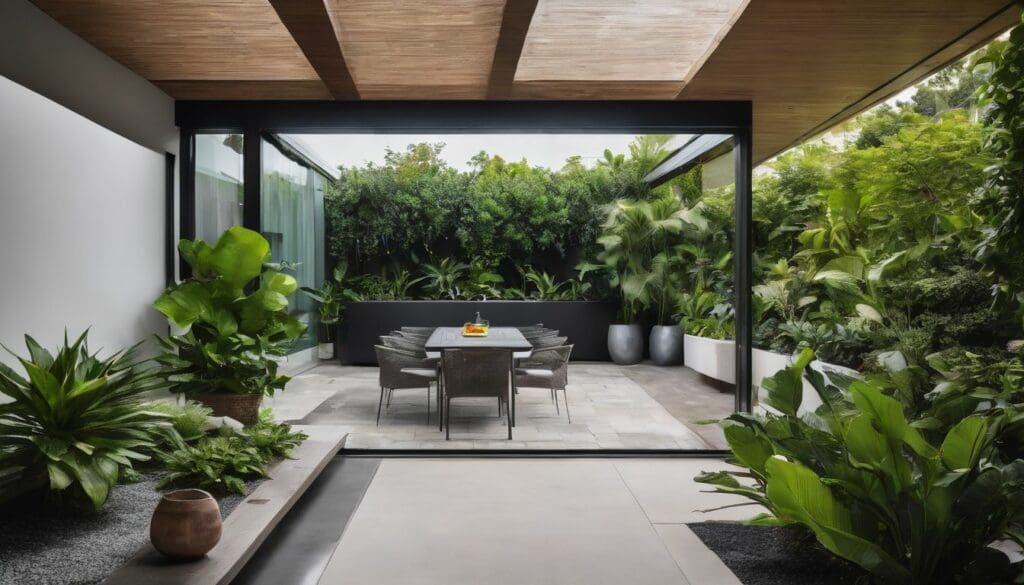Keeping your plants thriving can often feel like a full-time job. Smart home gardens are transforming that chore into a pleasure, using technology to simplify plant care. Our blog post will guide you through creating an automated oasis that lets you enjoy lush greenery without the guesswork.
Dive in and watch your garden grow!
Key Takeaways
- Smart home gardens make use of technology, such as automated irrigation systems and smart monitors, to ensure plants receive precise care with minimal human intervention.
- Environmentally conscious individuals can benefit from these technologies by conserving resources like water and energy while also promoting sustainable practices, including growing their own vegetables indoors.
- Adopting smart gardening devices leads to improved plant health and growth due to the accurate provision of water, light, and nutrients without constant monitoring or maintenance.
- Upgrading your garden into a smart one involves considerations like location accessibility for power/Wi-Fi, types of plants you’re growing, budget planning, local weather conditions and long-term scalability plans.
- Success stories highlight that converting to smart gardening setups not only contributes positively towards the environment but provides substantial time savings and cost reductions in plant care routines.
What is Smart Home Technology?
Smart home technology refers to the use of automated systems and smart devices to control, monitor, and manage various aspects of a home. This can include everything from lighting, heating, security systems, entertainment devices to even plant care in the form of smart gardening devices.
Definition and examples
Smart home technology blends devices and software for automated management of home functions and features. Examples include intelligent thermostats that adjust the temperature based on your habits or lights that turn off when a room is empty.
This tech extends to gardens, where automated plant care systems can water plants precisely when needed without any guesswork involved.
Indoor gardening automation takes this a step further with systems like smart planters which monitor soil moisture levels and provide nutrients accordingly. Robotic mowers trim your lawn while you relax, and connected gardens allow you to control everything from an app, ensuring your indoor greens flourish effortlessly.
Today’s environmentally conscious individuals appreciate how these innovations help conserve resources while nurturing their garden’s growth. Next, we’ll dive into how smart technology seamlessly integrates into modern gardening practices.
The Integration of Smart Technology in Gardening
Gardeners are now able to benefit from the integration of smart technology, with a range of devices designed to make plant care easier and more efficient. To learn about the benefits and recommended devices for smart gardens, keep reading.
Benefits for gardeners
Smart home gardening offers several benefits for environmentally conscious individuals. By utilising automated plant care systems and indoor gardening automation, gardeners can significantly reduce their environmental impact.
These smart gardening solutions help conserve water, minimise energy consumption, and reduce the need for harmful chemical pesticides. Additionally, smart gardens promote sustainable practices by enabling users to grow their own fruits and vegetables indoors, reducing the carbon footprint associated with transportation and packaging.
Incorporating smart technology into gardening not only supports conservation efforts but also provides a hassle-free experience for gardeners. With features such as remote monitoring and automated irrigation, individuals can enjoy improved plant health and growth without dedicating extensive time or effort to traditional maintenance tasks.
Types of smart gardening devices
Enhancing your gardening experience can be achieved through various types of smart gardening devices, each designed to revolutionise plant care. Explore the following innovative tools and equipment:
- Automated Irrigation Systems: These systems use sensors to monitor soil moisture levels and deliver precise amounts of water to plants, promoting efficient water usage while ensuring optimal hydration.
- Smart Plant Monitors: These devices track essential environmental factors such as light levels, temperature, and humidity, providing real-time data that enables you to adjust growing conditions for healthier plant growth.
- Automated Fertiliser Dispensers: These automated systems accurately distribute nutrients to plants based on their needs, delivering the right amount at the right time for maximum effectiveness and reduced waste.
- Smart Garden Cameras: By capturing images and videos of your garden, these cameras provide visual insights into plant health and growth progress, allowing you to closely monitor their development remotely.
- Connected Planters and Pots: Equipped with built-in sensors and automated watering capabilities, these intelligent containers optimise water distribution and foster ideal growing conditions for indoor or outdoor plants.
- Robotic Gardeners: Automated robots are designed to perform various tasks such as weeding, pruning, or even harvesting crops, reducing the manual labour required in maintaining a thriving garden.
How to Build or Convert Your Garden into a Smart Garden
Consider the layout and size of your garden, as well as the types of plants you want to grow, before selecting and installing smart gardening devices. To learn more about how to convert your garden into a smart garden, read on for helpful tips and recommendations.
Factors to consider
When converting your garden into a smart garden, there are several important factors to consider:
- Location: Choose an area with easy access to power and Wi-Fi for setting up smart gardening devices such as automated irrigation systems and sensors.
- Plant Selection: Consider the types of plants you want to grow and ensure that the smart gardening devices you choose are compatible with their specific needs.
- Budget: Determine the amount you are willing to invest in smart gardening technology, including the cost of devices, apps, and possible maintenance expenses.
- Weather Conditions: Take into account the local climate and weather patterns when selecting smart gardening devices to ensure they can withstand environmental factors.
- Scalability: Think about whether you want to start small or have plans for expansion in the future, as this will influence the type and number of smart gardening devices you need.
Recommended devices
To build or convert your garden into a smart garden, consider the following recommended devices:
- Smart Irrigation Systems: These devices allow for precise watering based on plant needs, conserving water and avoiding over-watering.
- Automated Plant Sensors: These sensors monitor soil moisture, light levels, and nutrients to provide real-time data for optimal plant care.
- Smart Grow Lights: LED grow lights can be programmed to simulate natural sunlight patterns, promoting healthy growth for indoor plants.
- Automated Garden Cameras: Wi-Fi enabled cameras provide live video feed of your garden, allowing remote monitoring and surveillance of plant health.
- Smart Planters with Self-Watering Systems: These containers automatically water plants as needed, reducing water waste and ensuring consistent watering.
The Advantages of Smart Home Gardens
Smart home gardens offer ease of use, improved plant health and growth, as well as time and cost savings. If you want to learn more about how smart home gardens can benefit your plant care routine, keep reading!
Ease of use
Smart home gardens offer unmatched ease of use, making it simple for environmentally conscious individuals to maintain a thriving garden. With automated gardening systems and smart plant care devices, tending to plants becomes effortless and convenient.
These innovative technologies allow users to monitor and manage their indoor gardens through user-friendly smart apps, ensuring that plant care fits seamlessly into daily routines.
Integrated automation in home gardens reduces the time and effort required for plant maintenance while also providing real-time data on plant health. This not only streamlines the process but empowers individuals to contribute towards conservation efforts by fostering healthy green spaces within their homes.
Improved plant health and growth
Smart home gardens contribute to improved plant health and growth through precise monitoring and automated care. This technology ensures that plants receive the right amount of water, light, and nutrients, leading to healthier and more robust growth.
By integrating smart gardening devices into your home garden, you can create an optimal environment for your plants to thrive without constant manual intervention.
Automated plant care systems provide real-time data on soil moisture levels, temperature, and light intensity. This information allows you to make informed decisions about adjustments needed in watering schedules or environmental conditions.
Time and cost savings
Smart home gardens offer significant time and cost savings for environmentally conscious individuals. With automated plant care systems, the need for constant manual monitoring and maintenance is reduced.
This not only saves valuable time but also cuts down on water and energy expenses, contributing to a more sustainable approach to gardening.
By eliminating the need for frequent watering, fertilising, and pest control, smart home gardens provide a cost-effective solution for maintaining healthy plants. The integration of smart technology in gardening minimises resource wastage while delivering optimal results.
Case Studies and Success Stories
Discover real-life examples of successful smart gardens, including customer testimonials that showcase the benefits of automated plant care and improved gardening experiences. Explore how others have achieved healthier plants, saved time and resources, and enjoyed the convenience of smart home garden technology.
Real-life examples of successful smart gardens
- A family in London transformed their small balcony into a flourishing smart garden using automated plant care systems like self-watering pots and IoT-controlled lighting.
- An urban apartment in New York City utilised indoor gardening systems with automated horticulture to grow fresh herbs and vegetables year-round, reducing their carbon footprint and grocery bill.
- A community garden in Sydney implemented a smart plant care system to monitor soil moisture and nutrition levels, resulting in healthier plants and increased yield without the need for excessive water or chemical inputs.
- An eco-conscious homeowner in Tokyo integrated smart home plant care devices to maintain an indoor oasis of air-purifying plants, contributing to a healthier indoor environment while reducing energy consumption.
Customer testimonials
Customers who have embraced smart home gardening technology have seen remarkable results. One customer, Sarah, reported significant improvements in her plant’s health and growth after implementing automated plant care systems in her garden.
She also highlighted the convenience of remotely monitoring and controlling her garden through her smartphone, saving both time and resources while ensuring her plants receive the best care.
Another satisfied customer, James, emphasised the positive impact on his environmental footprint with reduced water usage due to precise irrigation control offered by smart gardening devices.
Conclusion
In conclusion, automated plant care in smart home gardens is revolutionising the way we nurture our indoor and outdoor plants. Smart technology offers convenient solutions for environmentally conscious individuals seeking to support conservation efforts.
With the rise of smart home gardens, automated plant care has become more accessible and efficient than ever before. Gardeners can now enjoy healthier plants while saving time and resources through the integration of IoT gardening devices.
FAQs
1. What is smart home garden automation?
Smart home garden automation is the use of advanced technology to care for indoor plants automatically, making it easier to maintain a thriving home garden.
2. Can automated indoor gardens be part of my existing home automation system?
Yes, many automated indoor garden systems are designed to integrate with broader home automation networks, using IoT gardening solutions for seamless plant care.
3. How does an automated plant care system work in a smart home environment?
An automated plant care system monitors your plants’ needs and adjusts water, light, and nutrients accordingly within a smart home setting.
4. Is the smart garden market growing due to these technologies?
Indeed! The rise of Smart Home Gardens has led to significant growth in the smart garden market as more people are adopting these convenient tools for their homes.





